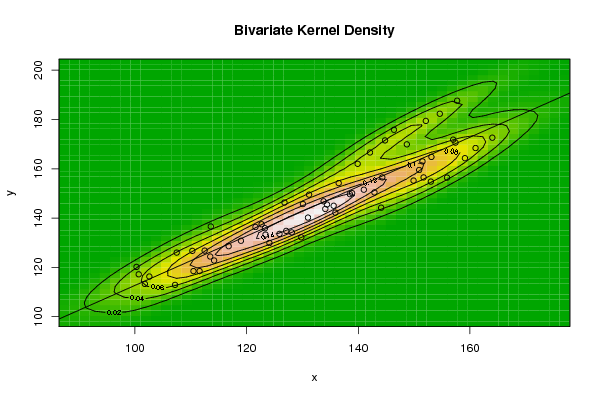Free Statistics
of Irreproducible Research!
Description of Statistical Computation | |||||||||||||||||||||||||||||||||||||||||||||
|---|---|---|---|---|---|---|---|---|---|---|---|---|---|---|---|---|---|---|---|---|---|---|---|---|---|---|---|---|---|---|---|---|---|---|---|---|---|---|---|---|---|---|---|---|---|
| Author's title | |||||||||||||||||||||||||||||||||||||||||||||
| Author | *The author of this computation has been verified* | ||||||||||||||||||||||||||||||||||||||||||||
| R Software Module | rwasp_bidensity.wasp | ||||||||||||||||||||||||||||||||||||||||||||
| Title produced by software | Bivariate Kernel Density Estimation | ||||||||||||||||||||||||||||||||||||||||||||
| Date of computation | Mon, 10 Nov 2008 05:17:20 -0700 | ||||||||||||||||||||||||||||||||||||||||||||
| Cite this page as follows | Statistical Computations at FreeStatistics.org, Office for Research Development and Education, URL https://freestatistics.org/blog/index.php?v=date/2008/Nov/10/t1226319594qnsmhce595l64fo.htm/, Retrieved Wed, 22 Oct 2025 16:18:33 +0000 | ||||||||||||||||||||||||||||||||||||||||||||
| Statistical Computations at FreeStatistics.org, Office for Research Development and Education, URL https://freestatistics.org/blog/index.php?pk=22987, Retrieved Wed, 22 Oct 2025 16:18:33 +0000 | |||||||||||||||||||||||||||||||||||||||||||||
| QR Codes: | |||||||||||||||||||||||||||||||||||||||||||||
|
| |||||||||||||||||||||||||||||||||||||||||||||
| Original text written by user: | |||||||||||||||||||||||||||||||||||||||||||||
| IsPrivate? | No (this computation is public) | ||||||||||||||||||||||||||||||||||||||||||||
| User-defined keywords | |||||||||||||||||||||||||||||||||||||||||||||
| Estimated Impact | 260 | ||||||||||||||||||||||||||||||||||||||||||||
Tree of Dependent Computations | |||||||||||||||||||||||||||||||||||||||||||||
| Family? (F = Feedback message, R = changed R code, M = changed R Module, P = changed Parameters, D = changed Data) | |||||||||||||||||||||||||||||||||||||||||||||
| F [Bivariate Kernel Density Estimation] [Bivariate Kernel ...] [2008-11-10 12:17:20] [e515c0250d6233b5d2604259ab52cebe] [Current] F RMPD [Hierarchical Clustering] [Q2 Various EDA] [2008-11-10 14:22:59] [5161246d1ccc1b670cc664d03050f084] F RMPD [Box-Cox Linearity Plot] [Q3 Various EDA] [2008-11-10 14:27:51] [5161246d1ccc1b670cc664d03050f084] | |||||||||||||||||||||||||||||||||||||||||||||
| Feedback Forum | |||||||||||||||||||||||||||||||||||||||||||||
Post a new message | |||||||||||||||||||||||||||||||||||||||||||||
Dataset | |||||||||||||||||||||||||||||||||||||||||||||
| Dataseries X: | |||||||||||||||||||||||||||||||||||||||||||||
136,5 146,4 157,7 148,7 154,6 152,1 144,8 142,1 157 159,1 164 151,5 135,9 138,5 161 151,7 142,9 157,4 138,9 141 150,9 149,9 153 144,3 128,1 123,3 155,9 144,1 134,1 153,1 131 129,8 139,9 135,6 126,8 134,4 113,5 107,5 133,8 119 125,9 130,1 114,2 111,6 131,2 124,1 127,1 123,4 100,7 100,3 121,6 110,5 110,3 122,7 102,6 101,8 113,6 107,2 116,8 112,5 | |||||||||||||||||||||||||||||||||||||||||||||
| Dataseries Y: | |||||||||||||||||||||||||||||||||||||||||||||
154,2 175,8 187,6 169,9 182,3 179,4 171,5 166,6 171,8 164,3 172,6 163 142,2 149,7 168,4 156,5 150,4 170,6 150,1 151,5 159,5 155,2 154,8 156,5 134,2 135,9 156,4 144,2 143,7 164,8 140,2 132,2 162 145 146,3 145,5 124,4 126 146,8 130,8 133,6 145,7 122,8 118,5 149,5 129,9 134,8 133,3 117,2 120,2 136,4 118,5 126,7 137,5 116,3 113,3 136,6 112,9 128,6 126,8 | |||||||||||||||||||||||||||||||||||||||||||||
Tables (Output of Computation) | |||||||||||||||||||||||||||||||||||||||||||||
| |||||||||||||||||||||||||||||||||||||||||||||
Figures (Output of Computation) | |||||||||||||||||||||||||||||||||||||||||||||
Input Parameters & R Code | |||||||||||||||||||||||||||||||||||||||||||||
| Parameters (Session): | |||||||||||||||||||||||||||||||||||||||||||||
| par1 = 50 ; par2 = 50 ; par3 = 0 ; par4 = 0 ; par5 = 0 ; par6 = Y ; par7 = Y ; | |||||||||||||||||||||||||||||||||||||||||||||
| Parameters (R input): | |||||||||||||||||||||||||||||||||||||||||||||
| par1 = 50 ; par2 = 50 ; par3 = 0 ; par4 = 0 ; par5 = 0 ; par6 = Y ; par7 = Y ; | |||||||||||||||||||||||||||||||||||||||||||||
| R code (references can be found in the software module): | |||||||||||||||||||||||||||||||||||||||||||||
par1 <- as(par1,'numeric') | |||||||||||||||||||||||||||||||||||||||||||||





